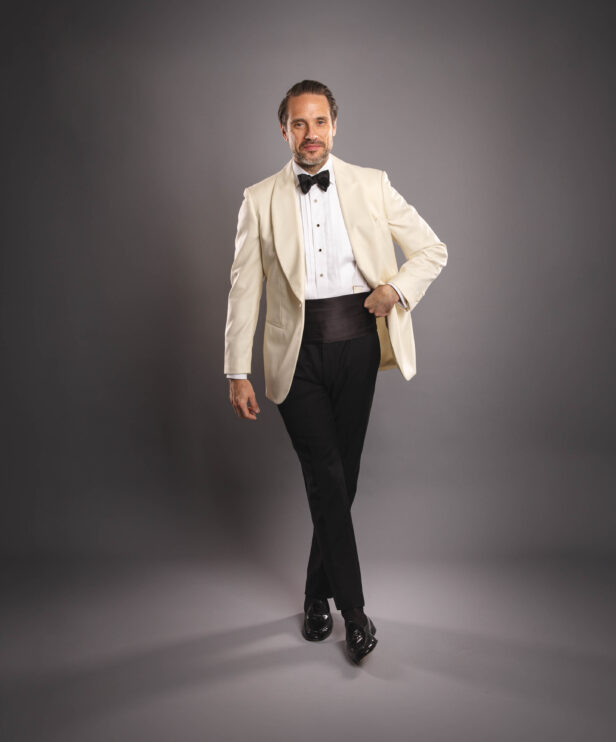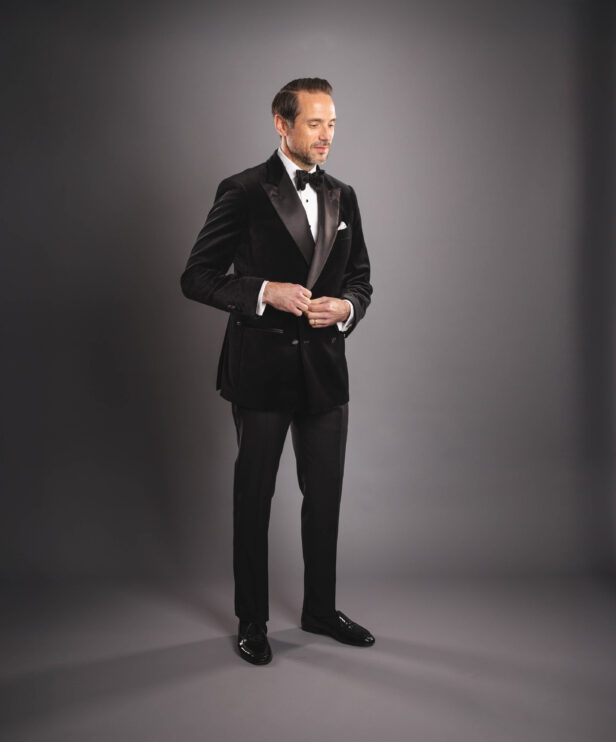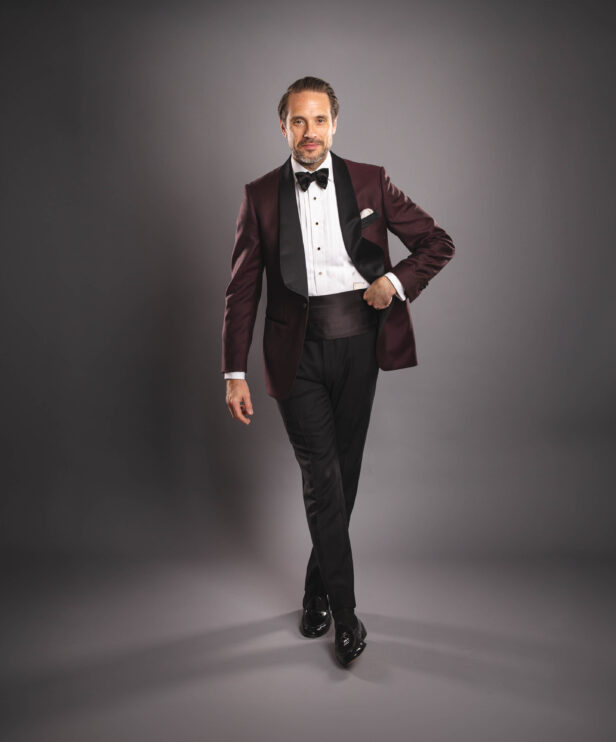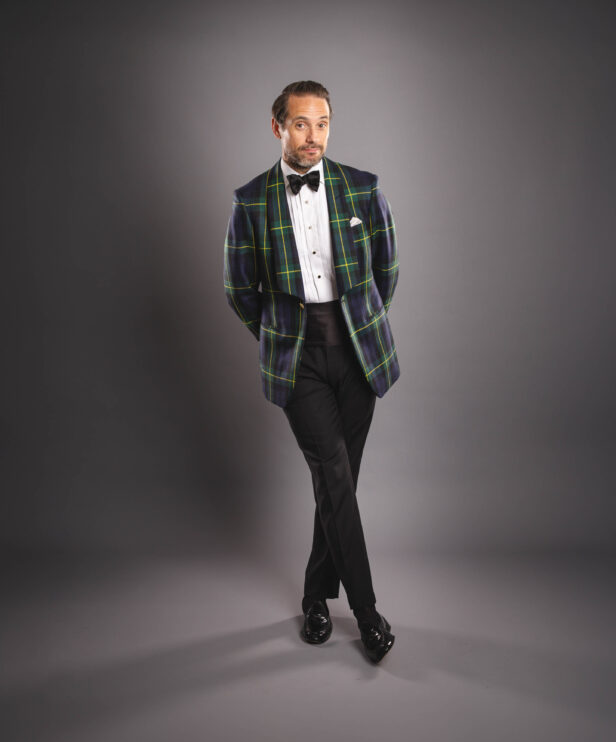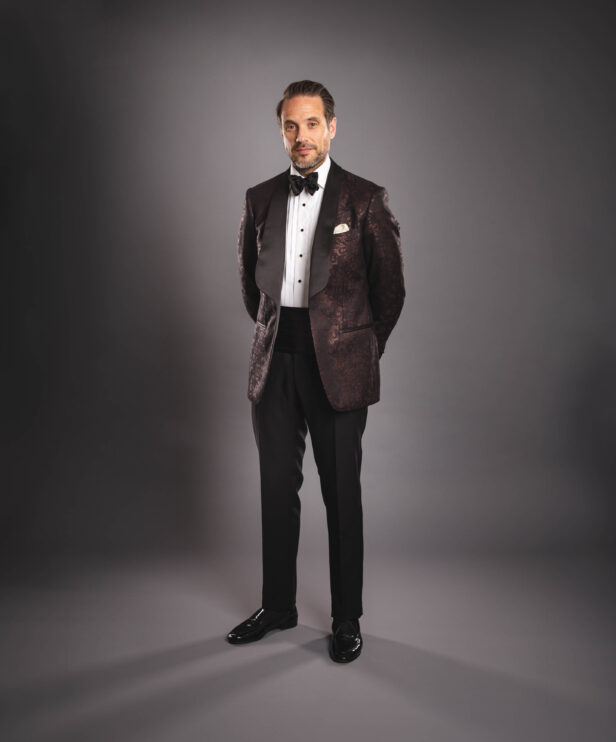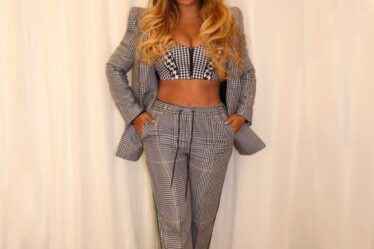
Written By
Logan Morford is a Communications Director in Lexington, Kentucky and nurtures a healthy love of James Bond and the idea of the gentleman spy.
T
There is perhaps no piece of menswear more closely associated with class and elegance than dinner jackets.
When properly executed, dinner jackets convey gravity and presence while instilling a sense of confidence that comes with the knowledge that you look that part. Wearing a dinner jacket is an event in and of itself.
Although most men won’t wear a dinner jacket with any significant degree of frequency, when the time comes it is important to have a solid understanding of how to properly wear a dinner jacket. Knowing the function of the jacket, when it is appropriate, and how to get the most out of the look are all important pieces of knowledge to have before you suit up.
Here is everything you need to know about dinner jackets.
What Exactly is a Dinner Jacket?
The dinner jacket, sometimes incorrectly referred to as a tuxedo jacket, is a formal garment that is considered more dressy than a traditional two piece suit, a blazer, or sport coat. When the time calls for more formal attire, the dinner jacket is the go-to garment for men.
While the terms tuxedo jacket and dinner jacket are often used interchangeably, there are some differences between the two. Tuxedo jackets sometimes feature tails while dinner jackets do not. A tuxedo jacket is worn with matching trousers, while a dinner jacket is worn, generally speaking, with tuxedo trousers though sometimes with an odd trouser — this can be particularly effective around the holidays.
Both jackets are considered formal and are interchangeably appropriate for black tie events, though it’s always best to confirm with the host whether they’d prefer a classic tuxedo or if a dinner jacket would suffice.
When Should You Wear A Dinner Jacket?
Dress codes — and in particular when and where to wear a particular garment — are perhaps one of the most discussed and debated topics in style these days. Style is deeply personal and individual. While guidelines for various dress codes have become, on the whole, much more casual and flexible over the past several decades, the rules for when to wear a dinner jacket have largely remained the same.
Dinner jackets are generally reserved for special occasions. Situations of importance. Donning a dinner jacket is more than just fitting into a prescribed dress code. It is also a frame of mind.
Here are some situations where dinner jackets are most commonly called into action.
- Weddings. Whether it is your own big day or you’re a groomsman, this is the most common and perfect time to wear a dinner jacket.
- Charity Events. These are always a great occasion to get dressed up and nothing says you take your charity of choice more seriously than a well-tailored dinner jacket.
- Black Tie Dinners. The dress code is in the title! A formal dinner requires a sharp dinner jacket to really do justice to the evening. Just be sure to confirm a dinner jacket is okay with the host. If not, it’s time to brush up on and break out your tux.
- Award Ceremonies. On the occasion that you or someone you know is receiving an award, pay full respect and honor by showing up in your best dinner jacket.
- Anniversaries. It is always appropriate to celebrate nuptials by donning your finest dinner jacket and treating your significant other to an elegant night out.
For most of us, these events are less common than a simple business lunch. Many of us may only experience some of these but once in our lives.
Dinner Jackets vs. Sport Coats
The primary differences between a dinner jacket and a standard suit jacket or sport coat are found in the details of the construction and styling. Some are easy to sport, some are more subtle.
Fabrics
Dinner jackets are typically constructed from finer, more luxurious fabrics than typically used for a traditional suit or sport coat. Velvet, silk, and mohair are fabrics commonly used in formalwear. These more luxurious fabrics lend an air of elegance and distinction, which is perfect for those more special occasions.
Lapels & Closure
Perhaps the most visually distinctive difference between a dinner jacket and a traditional suit is the structure of the lapels. Like a tuxedo jacket, dinner jackets almost always feature a satin or grosgrain lapel. Additionally these lapels are often peak or shawl which proves an additional element of formality and elegance. Unless it is double-breasted, a dinner jacket (and tuxedo jacket, for that matter) will have a single-button closure as opposed to the common two and three buttons on a traditional suit.
Occassion
The occasion when a dinner jacket and sport coat are appropriate are the primary difference between the two. Dinner jackets and tuxedos are reserved for formal attire while conventional suits and sport coats serve a more everyday purpose.
How Should You Style & Accessorize A Dinner Jacket?
There are some very simple but important guidelines for how a dinner jacket should be styled and accessorized. Let’s consider everything.
- Tie. A bow-tie (most often black) is an essential accessory for a dinner jacket. While the bow-tie is most common, the guidelines for this have changed over the years. More and more, red carpet looks with dinner jackets feature neck ties or even no tie at all. Although these are more fashion forward approaches, we recommend the bow-tie will as a classic, go-to look, and suggest experimenting with different shapes.
- Trousers. You’ve got two options here. Wear a pair of black tuxedo trousers for the most classic look. Around the holidays, you may consider a more festive pair. If attempting the latter, be sure to keep the jacket as simple as possible.
- Shoes. You can never go wrong with a pair of patent leather lace ups. However, because of a dinner jacket being slightly less formal than a full tuxedo, you may safely opt for a pair of velvet slippers or patent loafers.
- Accessories. With a properly tailored dinner jacket, accessories should be kept to a minimum. Be sure you’ve got an elegant set of tuxedo studs and cufflinks as well as a silk or linen pocket square. And a classic dress time piece on a black leather strap is ideal.
- Less is more. As with many things in life, dinner jackets look best when they are able to stand on their own. Keep things simple and let it be the star of the show.
Dinner Jacket Outfit Ideas
Now that we’ve established what exactly a dinner jacket is, when to wear one, and some basic rules for styling and accessorizing, let’s take a look at all of those things in practice. Here are five classic dinner jacket outfits.
Classic Ivory
When it comes to a dinner jacket, there is nothing more elegant and timeless than an ivory (a.k.a. off-white or cream) dinner jacket. With a self-facing shawl lapel, it is the ultimate nod to old Hollywood glamor that still looks striking today.
Double-Breasted Velvet
Another classic option with a bit of a sartorial twist. Like ivory, you can never go wrong with a dinner jacket in black velvet — it exudes elegance and captures the somewhat playful nature of the dinner jacket. In a 4×2 double-breasted styling, it’s a timeless yet bold choice.
Burgundy
A burgundy dinner jacket is an excellent way to keep it classic while standing out from the crowd without venturing into the “look at me” waters. While always a good choice, burgundy is extremely well suited for festive events around the holidays.
Festive Tartan
Speaking of festive, if you’re going to do it, why not go all out? Having a standout dinner jacket in your wardrobe, such as our Gordon tartan version is honestly all you need to start hosting an annual holiday cocktail party. Well, you’ll also need a pitcher of martinis, but the dinner jacket is a great start!
Subtle Statement
When we’re talking about formalwear, dinner jackets provide one of the best ways to demonstrate your style and personality, so don’t be afraid to have a little fun. Make a statement with your dinner jacket either somewhat subtly — as shown — or turn it up to 11, if you dare!
The Bottom Line
For a formal occasion, a dinner jacket is a classic, timeless choice. When worn properly, you will do justice to both the event you’re attending and your own sense of style. A minimalist approach will yield the best results — just make sure you’ve nailed the fit.

